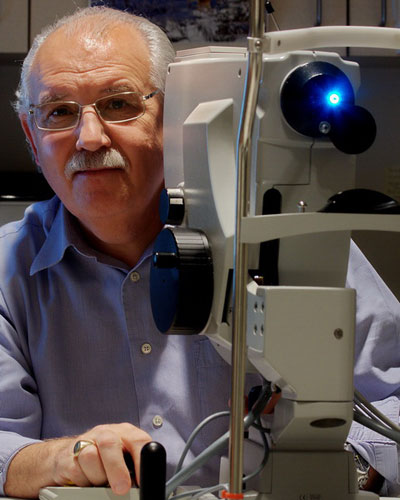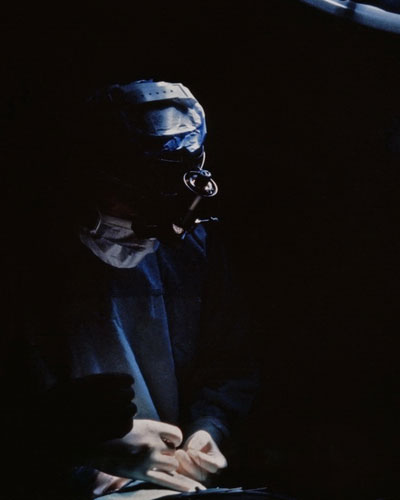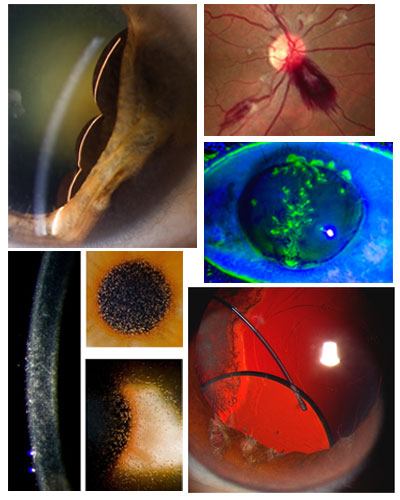
Allan Connor began his career at Princess Margaret in 1974 using traditional cameras and developing film in an in-house dark room. He’s retiring at the top of his game in the highly technical and specialized field of ophthalmic imaging. (Photo: Allan Connor)
Allan Connor's first experience with a camera offered no hint of the success to follow.
It was the 1960s in Glasgow, Scotland. A teenaged Allan had just received his first camera, a classic Kodak Brownie. It was a coveted gift he'd requested ahead of a family vacation to the Lascaux Caves in southwestern France, home to some of the world's best known Paleolithic cave paintings.
"I'd not really thought ahead," Allan recalls with a laugh. "Because when you're in a cave, a camera doesn't do you any good. I didn't get any pictures but I have always had them in my mind."
A half century on, Allan has built a career on getting the picture. An Ophthalmic Imaging Specialist at Princess Margaret Cancer Centre, and Manager of PhotoGraphics at UHN, he is retiring from the highly technical and specialized field as one of the best in the business, a fact evidenced by the large collection of awards for images of eyeballs lining the walls of his 18th floor clinic office.
Using sophisticated cameras and scanners, ophthalmic imagers document eye cancer over time. Allan, who over the course of a week takes photographic and ultrasound images of the eyes of about 50 patients, says the work is "a key diagnostic tool" for oncologists and other specialists. He likens the importance and usefulness of ophthalmic imaging to that of any other diagnostic technique.
Ultimately though, like any type of photography, it comes down to the look of the final image.
"If I can show a person's disease in the best way possible, then it's a bonus for them, it can help improve their care and hopefully their outcome," Allan says. "That, after all, is what I'm paid for.
"If my colleagues like my work, then that's a bonus."
The son of a family physician in Scotland, Allan completed his formal photographic training at the Glasgow College of Printing and was working as a commercial photographer in his hometown when the family moved to Canada, settling in London, Ont. He was 21.
Allan was working as a freelance photographer in London, focusing on a range of subjects from commercial heavy engineering at General Motors Diesel to portraits of members of London City Council, when a job came open as medical photographer at Toronto Western Hospital (TW). Always fascinated by medical and science photography, he applied. He didn't get the job.
Fortunately for Allan, the man who did get it never showed up. Two weeks later, the boss at TW called and asked him if he still wanted the job. It was 1969.

This picture of surgeons in the operating room is just one of the many memorable images Allan Connor has captured over the past 40 years. (Photo: Allan Connor)
"I drove down to Toronto and the rest is history," says Allan, who spent three years at TW before moving to Sunnybrook Hospital for two years. He became the Manager of Medical Photography at Princess Margaret in 1974, when the hospital was still located on Sherbourne Street.
"He's world renowned in the eye business," says Dr. Rand Simpson, past Director of the Ocular Oncology Program, who was in that position for about 25 years of Connor's tenure at Princess Margaret. "Imaging is a huge part of our methodology here and there's no one better at it than Allan.
"He's careful. He's fastidious. He's the kind of guy who makes sure things don't go wrong."
In addition to Allan's great understanding of the sweeping technological changes to impact imaging over the years, Dr. Simpson also always appreciated the Scotsman's unflappability, dry sense of humour, quick wit and easy-going nature.
"I've never heard a harsh word from him in 40 years," Dr. Simpson says. "He may have wanted to say it, but he never did."
Dr. Hatem Krema, the current Director of the Ocular Oncology Program at Princess Margaret, says Allan's "professional and insightful" work has played an important role in the care of patients.
"He could provide images of tumours in most difficult locations in the eye with such precision and clarity that enabled me to provide the right decision in patient management," Dr. Krema says. "His in-depth understanding of the potentials and limitations of his imaging instruments and his artistic talent produced text-book class photographs and earned him international reputation and awards."
Allan's career has spanned monumental technology changes – from standard cameras and processing film in-house, to Macintosh computers, black and white laser printers retailing for $7,000, to today's quartet of highly specialized imaging machines, he's seen it all. The four machines now used in his 18th floor clinic office include two ultrasound machines, one invented at Princess Margaret, one advanced camera which costs $160,000 and an optical coherence tomography, or OCT scanner.

A collection of some of the many award-winning images of eyeballs Allan Connor has captured in recent years as an Ophthalmic Imaging Specialist at Princess Margaret.
"If you don't keep up, you're not going to be here," Allan says of the need to stay on top of technology. "But it's also a development in your field, so you have an interest in it."
Bette Johnston met Allan soon after his arrival at Princess Margaret in 1974, when she was with the Hospital Auxillary and Hospital Board. His work was always outstanding, from his documenting two visits of HRH Princess Margaret, to creating a pictorial archive when the site switched from Sherbourne Street to University Avenue, to recording the opening of the current 16th floor Roof Garden.
"He was just always available, always there," says Bette, who also worked with Allan in her role as CEO of The Princess Margaret Hospital Foundation and as Director of Volunteer Resources. "If you ever needed anything done, you called Allan. He really is a special man and valued friend."
Colleagues in PhotoGraphics and Ocular Oncology offer similar sentiments about Allan, who along with his wife, Sandra, has two sons and two grandchildren, with a third on the way.
"His managing skills and talent as a photographer kept the place humming," says former colleague Marlene De Chellis. "And his respect for his team got the job done."
Lee Penney, Manager of Ocular Oncology, has known Allan for 20 years and says his "team approach" has always worked to the benefit of patients and staff alike.
"The team has been the glue that's kept us together and he's played a significant role in that," Lee says. "It's been a family approach to patient care."
Keith Oxley, who until retiring in 2009 drove daily from Mississauga with Connor for 30 years and estimates they logged the equivalent of more than four times around the earth, says his friend "was always a good boss.
"He tried not to micro-manage and trusted his staff to get the job done," says Keith.
Bruna Ariganello started working in PhotoGraphics about 16 years ago and says she initially thought Allan was serious but soon realized he was a great storyteller with a wonderful sense of humour.
"He was and is the kind of boss you need and hope for," Bruna says.
Allan admits that over the years some people have said his eye images are unsettling. But as he points to the striking and award-winning shots lining the walls of his clinic, he notes the unique characteristics of each photo and what vital information they offered the doctor caring for the patient.
"I'm taking pictures of some pretty unpleasant, gross things," he offers. "But at the same time, some of it is very abstract and not unattractive. I wouldn't say it's art, but it can be artistic."
